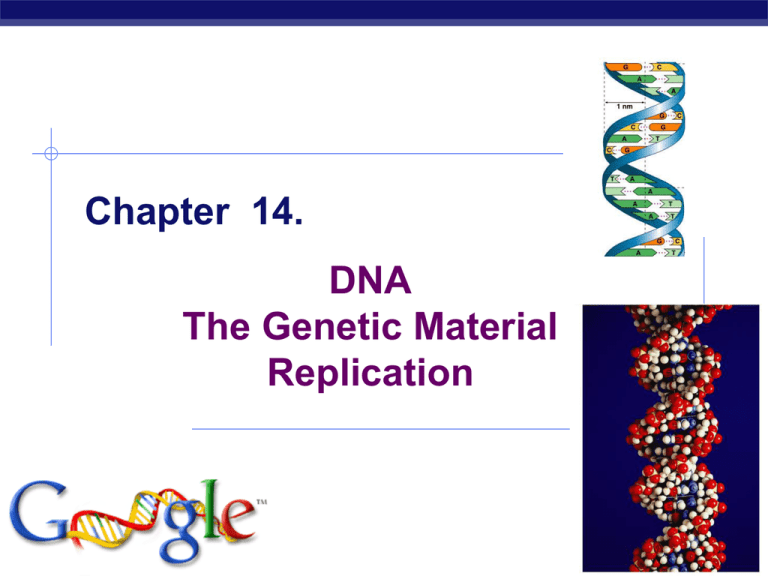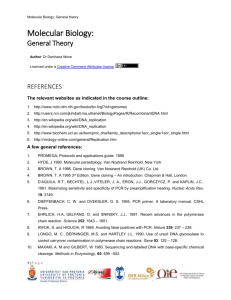Chapter 16. - Environmental
advertisement

Chapter 14. DNA The Genetic Material Replication AP Biology 2005-2006 Watson and Crick AP Biology 1953 article in Nature 2005-2006 Rosalind Franklin (1920-1958) AP Biology 2005-2006 Double helix structure of DNA the structure of DNA suggested a mechanism for AP Biology 2005-2006 how DNA is copied by the cell Directionality of DNA You need to PO4 nucleotide number the carbons! it matters! N base 5 CH2 This will be IMPORTANT!! O 4 3 AP Biology 1 ribose OH 2 2005-2006 The DNA backbone Putting the DNA backbone together refer to the 3 and 5 ends of the DNA the last trailing carbon I mean it… This will be IMPORTANT!! AP Biology 5 PO4 base CH2 O C O –O P O O CH2 base O OH 3 2005-2006 Anti-parallel strands Phosphate to sugar bond involves carbons in 3 & 5 positions DNA molecule has “direction” complementary strand runs in opposite direction “It has not escaped our notice that the specific pairing we have postulated immediately suggests a possible copying mechanism for the genetic material.” AP Biology Watson & Crick 2005-2006 Bonding in DNA 5’ hydrogen bonds 3’ phosphodiester bonds 3’ 5’ ….strong or weak bonds? How do the bonds fit the mechanism for copying DNA? AP Biology 2005-2006 Base pairing in DNA Purines adenine (A) guanine (G) Pyrimidines thymine (T) cytosine (C) Pairing A:T C : G AP Biology 2005-2006 Copying DNA Replication of DNA AP Biology base pairing allows each strand to serve as a pattern for a new strand 2005-2006 Models of DNA Replication verify through experiments… Alternative models AP Biology so how is DNA copied? 2005-2006 Semi-conservative replication 1958 Meselson & Stahl label nucleotides of “parent” DNA strands with heavy nitrogen = 15N label new nucleotides with lighter isotope = 14N “The Most Beautiful Experiment in Biology” parent replication make predictions… AP Biology 2005-2006 Semi-conservative replication 1958 Make predictions… 15 AP Biology N strands replicated in 14N medium 1st round of replication? 2nd round? 2005-2006 DNA Replication let’s meet the team… Large team of enzymes coordinates replication AP Biology 2005-2006 Replication: 1st step Unwind DNA helicase enzyme unwinds part of DNA helix stabilized by single-stranded binding proteins single-stranded binding proteins AP Biology 2005-2006 Replication: 2nd step Bring in new nucleotides to match up to template strands But… the Where’s We’re missing ENERGY forsomething! the bonding! What? AP Biology 2005-2006 Energy of Replication Where does the energy for the bonding come from? energy You remember ATP! Is that the only energy molecule? CTP TTP GTP ATP AP Biology AMP CMP TMP GMP ADP 2005-2006 Energy of Replication The nucleotides arrive as nucleosides DNA bases with P–P–P DNA bases arrive with their own energy source for bonding bonded by DNA polymerase III ATP AP Biology GTP TTP CTP 2005-2006 5' Replication Adding bases 3' energy DNA P III can only add energy nucleotides to 3 end of a growing DNA strand energy strand grow 5'3’ B.Y.O. ENERGY energy 3' AP Biology leading strand 5' 2005-2006 5' 3' 5' 3' ligase energy 3'AP Biology lagging strand 5' 3' leading strand 2005-2006 5' Leading & Lagging strands Leading strand - continuous synthesis Okazaki Lagging strand AP Biology - Okazaki fragments - joined by ligase 2005-2006 - “spot welder” enzyme Okazaki fragments AP Biology 2005-2006 Priming DNA synthesis DNA polymerase III can only extend an existing DNA molecule cannot start new one cannot place first base short RNA primer is built first by primase starter sequences DNA polymerase III can now add nucleotides to RNA primer AP Biology 2005-2006 Cleaning up primers DNA polymerase I removes sections of RNA primer and replaces with DNA nucleotides AP Biology 2005-2006 Replication fork DNA polymerase I DNA polymerase III Draw this in your notes and label each of the structures and their function lagging strand Okazaki fragments 5’ 3’ 3’ primase ligase 5’ SSB 5’ 3’ helicase DNA polymerase III 5’ 3’ leading strand direction of replication AP Biology 2005-2006 And in the end… Ends of chromosomes are eroded with each replication an issue in aging? ends of chromosomes are protected by telomeres AP Biology 2005-2006 Telomeres Expendable, non-coding sequences at ends of DNA short sequence of bases repeated 1000s times TTAGGG in humans Telomerase enzyme in certain cells enzyme extends telomeres prevalent in cancers Why? AP Biology 2005-2006 Replication bubble Adds 1000 bases/second! Which direction does DNA build? List the enzymes & their role AP Biology 2005-2006 Replication enzymes helicase DNA polymerase III primase DNA polymerase I ligase single-stranded binding proteins AP Biology 2005-2006 DNA polymerases DNA polymerase III 1000 bases/second main DNA building enzyme DNA polymerase I 20 bases/second editing, repair & primer removal DNA polymerase III enzyme AP Biology 2005-2006 Editing & proofreading DNA 1000 bases/second = lots of typos! DNA polymerase I proofreads & corrects typos repairs mismatched bases excises abnormal bases repairs damage throughout life AP Biology reduces error rate from 1 in 10,000 to 1 in 100 million bases 2005-2006 Fast & accurate! It takes E. coli <1 hour to copy 5 million base pairs in its single chromosome divide to form 2 identical daughter cells Human cell copies its 6 billion bases & divide into daughter cells in only few hours remarkably accurate only ~1 error per 100 million bases ~30 errors per cell cycle AP Biology 2005-2006 What’s it really look like? 1 2 3 4 AP Biology 2005-2006 The “Central Dogma” flow of genetic information within a cell transcription DNA RNA translation protein replication AP Biology 2005-2006 Any Questions?? AP Biology 2005-2006




